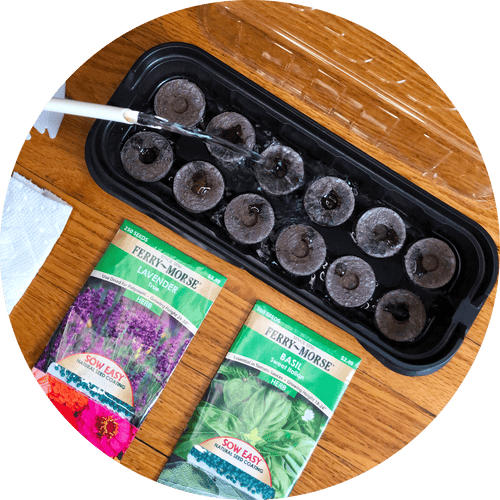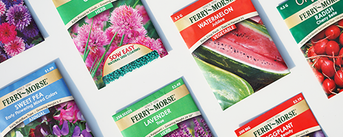Ferry-Morse Home Gardening Blog - February 8, 2021
Indoor Seed Starting Using Jiffy Peat Pellet Greenhouses:
A Step-by-Step Walkthrough

As you continue to garden over the seasons, you’ll learn what works for you and what doesn’t — but that comes with exploring your options. Some gardeners prefer to start their seeds indoors using Jiffy peat pellet greenhouses because of their structural and design benefits, using peat to start your seeds has its perks and transplanting seedlings growing out of the expanded peat pellets is very convenient. In this article we’ll be walking you through the steps of using any of the Jiffy peat pellet greenhouses, from their assembly all the way to putting them to use.
First thing's first! A list of what you'll need:
1. Your Greenhouse. Removed from its packaging sleeve; you can set the clear plastic humidity dome (also known as the Gro-Dome) aside for now
2. Seeds. You will need the seeds you would like to start inside of the pellets (tomatoes, peppers, cosmos, and zinnias are favorites for seed starting!)
3. Water. Preferably lukewarm or warm. We recommend using the amount of water suggested on the instructions (back of packaging sleeve) BUT you can also eye-it and add or drain any water as you deem necessary. You want the pellets to be saturated but not soggy
Here's what's optional (not required but recommended):
A towel or paper towel. This is to wipe-up any spillage or clean your hands throughout the process
Plant markers. (you’ll want to be sure to mark the rows or sections of the pellets in your tray so you can remember which seedling is which)
A fork. (this is only if you don’t want to get your fingers dirty when fluffing up the top layer of peat — you’ll learn more about this part further down!)
Now that we've got everything we need, let's jump in!
STEP 1: Add your lukewarm/warm water to your pellets.

A couple of things to note during STEP 1 — there is NO such thing as using too much water (unless it’s spilling out of your tray). If, after your peat pellets have fully expanded, there is still water sitting in the tray then you can carefully pour it out.
You may notice that your peat pellets will start floating to the surface. This is OK! Simply take your finger, or a fork, and gently submerge the pellets again. The base of some pellets might even get stuck in their tray slots as they absorb, which keeps the pellet from fully expanding. This is OK too, just work the bottom of the pellet out of its slot with your finger.

Gently work the pellets with your fingers as they absorb water in order to help shape them a little.
Another little tip in getting your pellets to expand fully is to gently roll them in the water on their sides. You can also gently squeeze the sides of the expanding pellets with your forefinger and thumb in order to help break up the moistening peat a little further. Feel free to shape your pellets a bit as well, it’ll only help in the long run!
STEP 2: Once your peat pellets have expanded, gently tear open their top netting with your fingers.

This step is easy peasy, just make sure you’re gentle about it. The netting should already be slightly open to you, which happens naturally as the pellet expands. Now it’s your turn to tear open that netting just a tiny bit more so you have enough room to work with when you’re on to sowing your seeds.
Don’t get nervous about tearing the netting too much, either. As long as the majority of the netting is still in place when you’re finished, your pellet will still be held together enough that when it’s time to transplant your seedlings, they’ll still be easily transferable. As seedling roots grow, the netting will also help keep the pellet intact.
STEP 3: Gently fluff the top layer of peat in preparation of sowing your seeds.

Gently fluff the top layer of peat with your fingers, a plant marker, a fork or anything you think will do the trick!
In the instructional picture above, the person fluffing the top layer of peat is doing so using the pointed end of Ferry-Morse Plant Markers. You can fluff the top layer of peat on your pellets with really anything that suits you. In the past, gardeners have used forks, their fingers AND we’ve even had some people say that left-over wooden chopsticks from your Friday night takeout will work wonders in peat fluffing!
Whatever way you tackle this step is up to you. In the end, the outcome needs to be this: that the top of the peat is moist and loose enough to welcome your seeds!
STEP 4: Sow your seeds following the instructions on your seeds packets.

Now that your peat pellet is all prepped and ready, it’s time to sow those seeds. We recommend sowing your seeds according to the instructions on your seeds packets OR however you’ve sown them in the past. Some seeds have very specific planting depths while others may prefer to sit right on top, with only a very light covering of soil (or in this case, peat).
Once the seeds are planted and covered, it’s important to mist the pellets to lightly “water in” the seeds.
Be sure to remember where you’ve sown what seeds, too. Most often, gardeners will either sow an entire variety of seeds per tray OR they’ll break the tray down into sections or rows and sow their seeds using this method. This choice is yours!
STEP 5: Place the clear plastic humidity dome on top of your greenhouse tray.

You’ve successfully expanded your peat pellets, you’ve drained any excess water, you’ve gently torn open the netting tops and fluffed your peat and now your seeds are sown! Well, one of your final steps is placing the clear plastic humidity dome on top of your watertight base tray.
This humidity dome is light and should fit very easily into place. It is not airtight and it is OK if you feel like air is getting into your greenhouse. Soon, you should see condensation working itself over the top and sides of the tray. This is from the warmth and moisture of your peat pellets!
NOTE: The dome should only stay on until you see first leaves appearing, leaving it on longer can harm the seedling — they require air for circulation to grow strong. If some of your seeds sprout earlier than others, simply pop the dome open. Completely remove dome once all seeds have sprouted.
The trick to ensuring that the seeds inside of your greenhouse germinate is this: keeping your peat pellets and the inside of the greenhouse moist and warm.
Final Step: Make sure your greenhouse is labeled and then either place it on a seed germinating heat mat OR store your greenhouse in a warm location out of direct sunlight.

Like we discussed earlier, make sure your peat pellets or sections of your greenhouse are labeled so you can remember what is growing and where. Greenhouse domes aren’t very high and therefore you won’t be able to use most standard sized plant labels right away. It’s easy to lay the plant markers over the pellets as well
As an alternative to this, some gardeners will use smaller paper plant markers OR you can tape your plant markers to the top of your greenhouse dome using scotch tape. Once your seeds begin to germinate (you see small sprouts appearing), you can pop open your greenhouse dome.
Once all of your seeds have germinated, you can completely remove your greenhouse dome and apply the plant markers where necessary. Place the dome back underneath your watertight tray for safe-keeping, until the next time you use it!
These trays and domes are fully reusable year after year just make sure to wash them before re-use.
Well then, you’re now basically an expert on assembling and using seed starting peat pellet greenhouses! The instructions and tips we discussed above are applicable to ALL Jiffy Seed Starting Peat Pellet Greenhouses so don’t be afraid to refer back here every time you’re putting one of these greenhouses to use.
Related Posts

Using Grow Lights and Heat Mats to Germinate Your Seeds and Mature Your Young Plants with Ease
Feb 2020 Ferry-Morse Home Gardening Team

How are Jiffy Seed Starting Indoor Greenhouses used? What are the benefits to using Jiffy's indoor greenhouses?
Jan 2021 Ferry-Morse Home Gardening Team


I bought your Seed starting kit. It says to use warm water to prepare the pellets. Do I put the Superthrive Plant Vitamin stuff into THAT water or after I have planted my seeds. The plant
vitamin packet came with the kit. Thanks! Please respond !
Hi Regina Michelle Hughes,
You should water your sprouts and/or seedlings when you begin to notice the peat pellet is getting dry. You can touch the pellets to see if the peat is dry or not; you can usually tell they’re dry and in need of water by sight, too.
Peat pellets should maintain an even moisture while your seedling roots continue to develop. You never want your peat pellets to be completely dry for long periods of time. Still! Overwatering will cause harm and potential rot. As long as they’re moist but not muddy, you’re doing just fine!
How often are you watering your seedlings?
Hello Sheryl,
Thank you for your question. Warmth, moisture and limited air circulation within the greenhouse when the humidity dome cover is on may sometimes cause this. No need to worry! They won’t harm your seeds, sprouts or seedlings. You can gently scrape anything off with some tissue or a paper towel.
To avoid it happening again, just prop your humidity dome open (maybe about 0.5") to let a bit more air in. If you do this though please keep in mind that the pellets may dry out a little faster and you’ll have to water or mist them a bit more frequently. Hope this helps!
Thank you for your question, Charles. You can purchase peat pellet refills here https://ferrymorse.com/collections/peat-pellets. Or! From our Menu, select Seed Starting > Peat Pellets > Shop All Peat Pellets. Hope this helps!